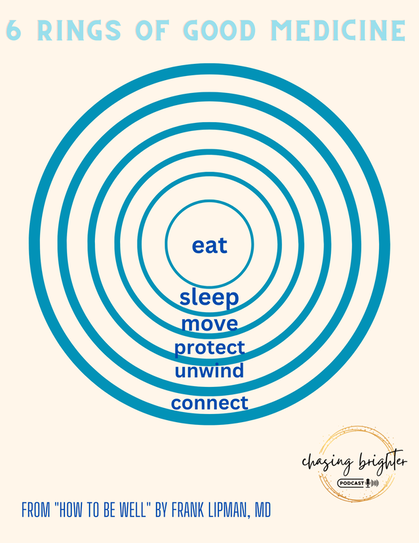
The reason we are a fan of Dr. Lipman and the concept of functional medicine is because functional/integrative medicine is intended to treat the whole person like holistic medicine. According to author and functional medical expert, Frank Lipman, MD, when we are looking at holistic health we should be focusing on a person’s resilience, function and synergy. Resilience refers to how well you face obstacles or challenges. Function is the focus of function of organs. Finally, synergy is the benefit of organs and systems work together.
Dr. Lipman says, “it’s the ordinary things we do on a daily basis that have an extraordinary effect on our health.”

Lipman has created The Good Medicine Mandala in the book –a new map for a new era of medicine. The Good Medicine Mandala is illustrated by a circular system of six rings that contain simple steps to what really works to improve and strengthen resilience, functioning, and overall health. The Six Rings of how to: eat, sleep, move, protect, unwind and connect. For anyone interested in health, wellness, and happiness, this gorgeously illustrated book is a must-haveAs seen in the graphic, Dr. Lipman’s book “How To Be Well” focuses on 6 key areas of health and well being. There are also 4 areas of our bodies that act like a compass within these 6 areas:
- Microbiome: bacteria, viruses, etc that are in our body.
- Inflammatory response: the measure of our immune system.
- Rhythms: including sleep, but also the rhythms with which we live.
- Balance: finding the yin to the yang
1. How to Eat
This chapter is about mastering the very building blocks of life: food.
Lipman quotes Wendell Berry who famously says, “People are fed by the food industry, which pays no attention to health, and are treated by the health industry, which pays no attention to food.”
Eat food that is closest to its natural source and abstain from processed foods. It is important for us to notice how the food we eat makes us feel. Overall we need to have vegetables in 50-70% of each meal, 10% protein and 20-30% good fats. In addition to this type of plate, we need to reduce the amount of sugar and processed foods that we eat.
Recommended books:
“Wheat Belly” by William Davis
“Grain Brain” by Dr. David Perlmutter and Kristin Loberg
“Real Food Heals” by Seamus Mullen
“Salt, Sugar, Fat” by Michael Moss
2. How to Sleep
This chapter is about restoring one of our most fundamental needs: sleep.
- Sleep allows our body to repair itself and gives our brain an opportunity to process the day’s information.
- Poor sleep quality or sleep deprivation is linked to mental health issues such as anxiety and depression.
- Poor sleep can also cause physical health problems.
- Getting less than 8 hours of sleep causes struggles in learning, memory impairment, emotional instability, and reduces decision making.
- Is recognized as a lifestyle factor contributing to risk of developing Alzheimers.
- Ok to take naps early in afternoon 20-25m
- Take a Nappucino!
- Drink a cup of coffee quickly. If you drink it too long before your nap, caffeine will kick in too early and prevent you from falling asleep.
- Power nap for approximately 20 minutes.
- Make sure to wake up on time. Napping for longer than 30 minutes will cause sluggishness rather than increase alertness.
3. How to Move
Moving is about helping the body move in the ways that nature intended. How to Movement is not about exercise or “working out”. It is about increasing movement throughout each day. Exploring how you can incorporate movement in ways that you enjoy. If you want to go to a gym; look for a place where staff make eye contact with you, encourage individuality and help adjust your body to ensure proper movement. Basically, Dr. Lipman encourages us to move throughout each day, lift heavy things and occasionally run (jump rope, HIT, etc).
4. How to Protect
This chapter is about mitigating and preventing the invisible assaults of everyday toxins. Not everything that is available to us is safe. Just because we can buy it and put it on our bodies, in our bodies or around our home, we can’t assume that it is safe or good for us. Avoid GMO’s, filter your water, and buy organic for household products.
Supplement Strategy
It’s important to buy supplements that use the best ingredients and are free of preservatives, fillers, binders, excipients, anit-caking agents, shellacs, coloring agents, gluten, yeast and lactose or other allergens. Most “top tier” brands are available from health practitioners like Be Well, Designs for Health, Metagenics, Xymogen for example.
- A good Multivitamin that contains vitamin D, B and magnesium.
- High-Quality Fish Oil: Fish oils contain the omega-3’s that support your body’s ability to prevent chronic diseases and help protect it against inflammation.
- A Probiotic: At least 20 billion CFU’s for everyday use.
- COQ10
- Glutathione
5. How to Unwind
Unwind is the idea of consciously switching off to allow for mental reprieve. Clearing your space is a way to clear your mind. Explore having “no tech” days where you remove screens and disconnect from devices. Practice saying “no” and setting better boundaries around your time. A great way to unwind is to engage in sexual intimacy. Meditation is a highly impactful strategy for unwinding.
6. How to Connect
Connection is about awakening and enhancing a sense of belonging and meaning.
- Get a pet
- Get out in nature
- Have meals with others
- Engage in touch with others or self-massage
- Be Kind and pay it forward
- Practice daily rituals
- Journal or write about your thoughts and feelings
- Practice gratitude
- Volunteer
- Make friends or actively participate in your current relationships